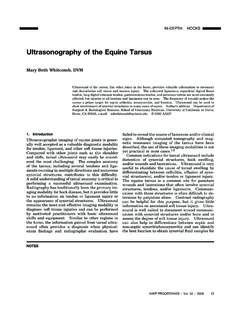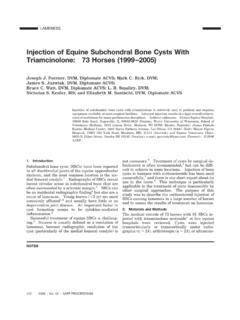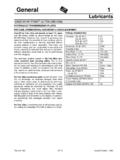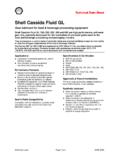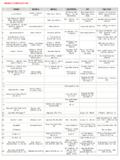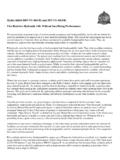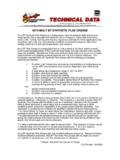Transcription of Principles of Treatment for Impaction – Laxatives, …
1 Principles of Treatment for Impaction laxatives , fluid Therapy and Analgesia Anthony T. Blikslager, DVM, PhD, Diplomate ACVS Author s Address: North Carolina State University, 4700 Hillsborough Street, Raleigh, North Carolina 27606. laxatives Laxative treatments for impactions include mineral oil, dioctyl sodium sulfosuccinate (DSS), and magnesium sulfate (Epsom salts). Practitioners are very familiar with these treatments, but it is worth considering a few points. laxatives should never be administered to horses with signs of proximal gastrointestinal obstruction (any small bowel disease). In these cases, the medications typically remain in the stomach for an extended period of time, and never make it to the site of obstruction (such as the ileum).
2 In addition, the additional filling of the stomach can exacerbate colic, and add to the volume of reflux. A second point is that it is absolutely vital to make sure that the tube is in the stomach. This seems like a simple point, but a full dose of mineral oil in the lungs is fatal, and although rare, this complication has happened, even to seasoned equine To be completely certain of tube placement, the gold standard is to be able to feel the tip of the tube in the proximal esophagus before pushing the tube down into the stomach (feel the horse swallow, immediately watch for the tube in the esophagus, then feel the tip of the tube). In addition, the laxative being administered should be carefully checked to make sure it is the correct medication.
3 For example, there is a case report of fatal administration of propylene glycol instead of mineral oil. This can happen because the containers from a single manufacturer look identical, and large animal practitioners may have both medications in their hospitals or Mineral oil ( 1 gallon) is typically administered for horses with signs indicative of a large colon Impaction . However, mineral oil can also be administered to horses with simple medical colic to prevent onset of an Impaction or to treat a potential Impaction that is out of reach during rectal palpation (such as an Impaction of the right dorsal colon). Mineral oil is a very useful marker of gastrointestinal transit in that it is usually present around the anus and tail within 18-hours if transit time is normal.
4 The appearance of mineral oil within this period of time will therefore confirm that there is no absolute obstruction. In addition, mineral oil is helpful for lubricating impacted ingesta. However, it has a propensity to work its way around the Impaction without penetrating it, so the appearance of mineral oil at the anus does not mean that the Impaction is resolved. Repeated treatments with mineral oil can be used, but the author will typically restrict this to a couple of treatments. Overloading the colon with mineral oil can make surgery much more challenging, so referral may be preferable if reasonable Treatment of Impaction in the field is not working.
5 Published in IVIS with the permission of the AAEPC lose this window to return to IVISDSS (10-50mg/kg in 2-4L water, or 6-8oz. in water) is an alternative to mineral oil. DSS is essentially a detergent, so it can penetrate impacted fecal material and break down the surface tension, thereby allowing water into the feces. The dose is important; a 3-fold overdose is fatal for horses (initial signs include increased respiratory rate and diarrhea).3 In addition, DSS should not be administered with mineral oil. Theoretically, the DSS can result in mucosal absorption of mineral oil, which may result in oil emboli. This has never been established in horses. DSS certainly seems to help break down impactions when directly infused during surgical procedures, so there is probably some validity as to its efficacy when administered by nasogastric tube.
6 However, one study suggested that the main effect of all laxatives is the gastrocolic reflex following filling of the stomach, so administration of water or electrolytes might ultimately be equally Magnesium sulfate ( 1g/kg mixed in water) is a more potent laxative and cathartic that has the ability to soften fecal It should be administered with the knowledge that excess amounts may cause electrolyte derangements (most notably hypermagnesemia). The latter has been noted at the higher dose, so one should consider using the dose. Of all the laxative medications, this is probably the most likely to soften the fecal mass itself, and should therefore be considered for impactions that are clearly evident on rectal palpation, particularly those refractory to mineral oil.
7 Magnesium sulfate is not effective in increasing colon water content compared to a balanced electrolyte solution but does increase the water content of feces in the small colon. Sodium sulfate, an even more potent cathartic, is very effective in hydrating the colon contents, but consistently causes hypernatremia and hypocalcemia, so is not fluid Therapy fluid therapy should be considered in horses with impactions that are refractory to treatments such as flunixin and mineral oil. Fluids can be administered either orally, or intravenously. The latter has been extensively used by referral hospitals taking care of refractory impactions, and in many instances veterinarians will give excessive IV fluids in the hope of over-hydrating colonic ingesta.
8 Recent studies suggest that this is unlikely to occur,5 so the main reason for giving IV fluids is to make sure any dehydration is corrected, and to make sure the horse continues to receive a maintenance level of fluids. This is because, although it is apparently difficult to overhydrate colonic contents, dehydration will result in dehydrated colonic contents because colonic fluid will be used to make up reduced circulating volume. Treatment of hypovolemia should begin with an estimate of the degree of dehydration, which can be based on the physical examination initially (delayed skin tent, appearance of a sunken eye) and confirmed by running a packed cell volume and total protein.
9 A horse that has a delayed skin tent (> 4-seconds) is at least 6% dehydrated, whereas horses in which the eye is sinking back in the orbit are at least 10%. Horses between these extremes can be estimated as 8% dehydrated to start with. Once the degree of dehydration has been estimated (6, 8, or 10%), the percentage is multiplied by the horse s body weight to give the fluid deficit ( , 8% dehydration x 500kg = 40L). The first half of the fluid deficit should be administered rapidly (up to 100ml/kg/h, or 50L/ hr in an adult horse) followed by the remainder at a slower rate ( , 3-5L/ hr). fluid administration is monitored by repeated measurements of the PCV and plasma protein.
10 In the field, if fluids are going to be administered, the veterinarian should be prepared to give approximately 15-20L, which corresponds to half the fluid deficit for an adult horse that is 6-8% dehydrated. A lesser volume (such as 2L) is not worth taking the time to administer, and referral is preferable. Once dehydration has been addressed, horses require 50ml/kg/day (approximately 1L/hr for the average horse) for maintenance, and additional fluids for any ongoing losses ( , sweat, reflux). An alternative to intravenous fluids is continuous infusion fluids via a small-bore nasal esophageal feeding tube. The methodology for this has recently been described by Lopes et Old fluid bags can be used, using water-containing electrolytes, and an infusion line attached to the nasal-esophageal tube.
